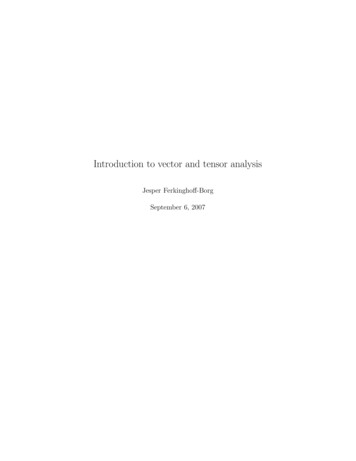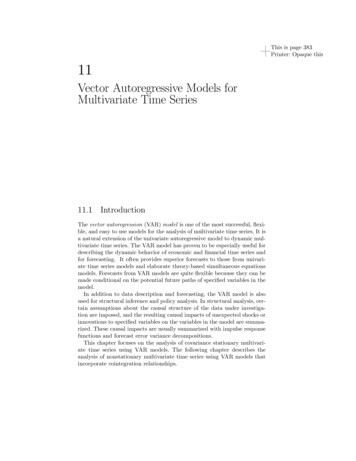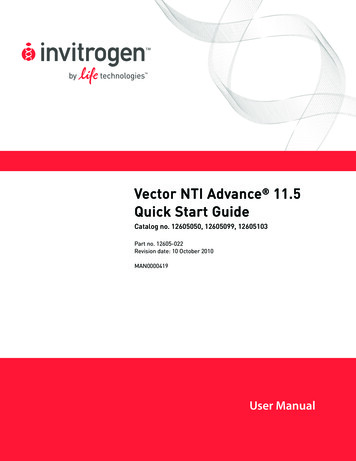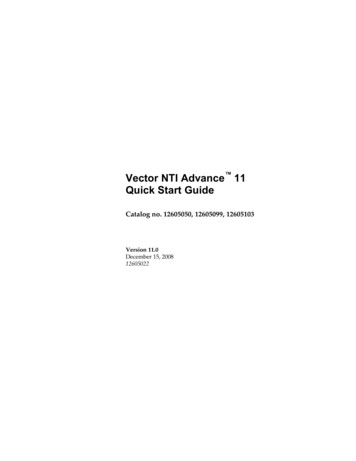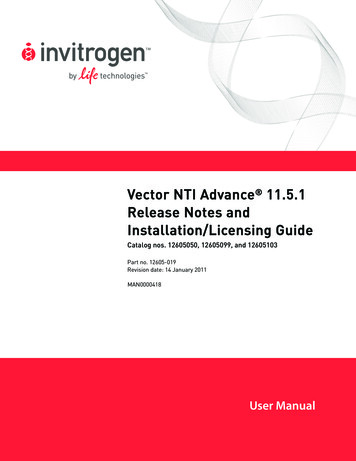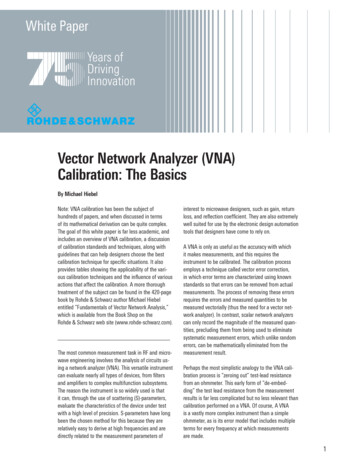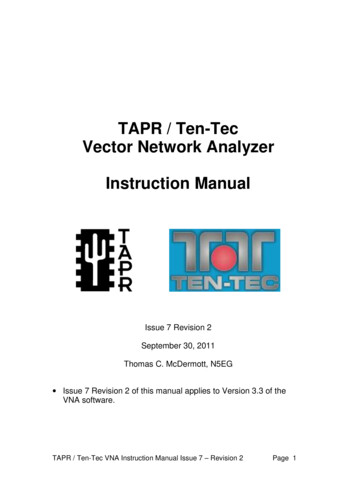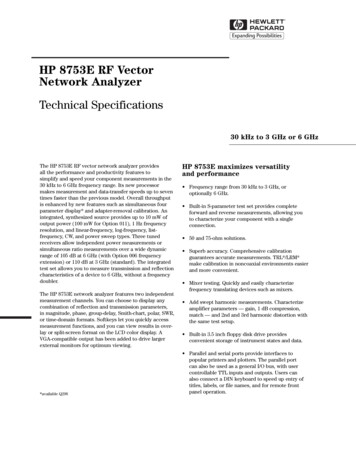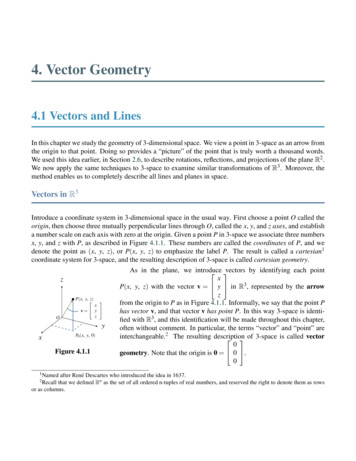
Transcription
4. Vector Geometry4.1 Vectors and LinesIn this chapter we study the geometry of 3-dimensional space. We view a point in 3-space as an arrow fromthe origin to that point. Doing so provides a “picture” of the point that is truly worth a thousand words.We used this idea earlier, in Section 2.6, to describe rotations, reflections, and projections of the plane R2 .We now apply the same techniques to 3-space to examine similar transformations of R3 . Moreover, themethod enables us to completely describe all lines and planes in space.Vectors in R3Introduce a coordinate system in 3-dimensional space in the usual way. First choose a point O called theorigin, then choose three mutually perpendicular lines through O, called the x, y, and z axes, and establisha number scale on each axis with zero at the origin. Given a point P in 3-space we associate three numbersx, y, and z with P, as described in Figure 4.1.1. These numbers are called the coordinates of P, and wedenote the point as (x, y, z), or P(x, y, z) to emphasize the label P. The result is called a cartesian1coordinate system for 3-space, and the resulting description of 3-space is called cartesian geometry.As in the plane, we introduce vectors by identifying each pointxzP(x, y, z) with the vector v y in R3 , represented by the arrowzP(x, y, z) fromtheorigintoPasinFigure4.1.1.Informally, we say that the point Px yv has vector v, and that vector v has point P. In this way 3-space is identizOfied with R3 , and this identification will be made throughout this chapter,yoften without comment. In particular, the terms “vector” and “point” areP0 (x, y, 0)interchangeable.2 The resulting descriptionx of 3-space is called vector0 Figure 4.1.1geometry. Note that the origin is 0 0 .01 Namedafter René Descartes who introduced the idea in 1637.that we defined Rn as the set of all ordered n-tuples of real numbers, and reserved the right to denote them as rowsor as columns.2 Recall209
210Vector GeometryLength and DirectionWe are going to discuss two fundamental geometric properties of vectors in R3 : length and direction. First,if v is a vector with point P, the length !v! of vector v is defined to be the distance from the origin to P,that is the length of the arrow representing v. The following properties of length will be used frequently.Theorem 4.1.1 x Let v y be a vector.z1. !v! %x2 y2 z2 .32. v 0 if and only if !v! 03. !av! a !v! for all scalars a. 4Proof. Let v have point P(x, y, z).z1. In Figure 4.1.2, !v! is the hypotenuse of the right triangle OQP, andso !v!2 h2 z2 by Pythagoras’ theorem.5 But h is the hypotenuseof the right triangle ORQ, so h2 x2 y2 . Now (1) follows byeliminating h2 and taking positive square roots.PvzOxRihyyxQFigure 4.1.22. If !v! 0, then x2 y2 z2 0 by (1). Because squares of realnumbers are nonnegative, it follows that x y z 0, and hencethat v 0. The converse is because !0! 0.&'T3. We have av ax ay azso (1) gives!av!2 (ax)2 (ay)2 (az)2 a2 !v!2 Hence !av! a2 !v!, and we are done because a2 a for any real number a.Of course the R2 -version of Theorem 4.1.1 also holds.3 Whenwe write p we mean the positive square root of p.(a if a 0. a if a 05 Pythagoras’ theorem states that if a and b are sides of right triangle with hypotenuse c, then a2 b2 c2 . A proof is givenat the end of this section.4 Recallthat the absolute value a of a real number is defined by a
4.1. Vectors and Lines211Example 4.1.1 )*2 3 If v 1 then !v! 4 1 9 14. Similarly if v in 2-space then 43 !v! 9 16 5.When we view two nonzero vectors as arrows emanating from the origin, it is clear geometricallywhat we mean by saying that they have the same or opposite direction. This leads to a fundamental newdescription of vectors.Theorem 4.1.2Let v % 0 and w % 0 be vectors in R3 . Then v w as matrices if and only if v and w have the samedirection and the same length.6zPvQwOyxFigure 4.1.3Proof. If v w, they clearly have the same direction and length. Conversely,let v and w be vectors with points P(x, y, z) and Q(x1 , y1 , z1 ) respectively. Ifv and w have the same length and direction then, geometrically, P and Q mustbe the same point (see Figure 4.1.3). Hence x x1 , y y1 , and z z1 , that isxx1v y y1 w.zz1A characterization of a vector in terms of its length and direction only is called an intrinsic descriptionof the vector. The point to note is that such a description does not depend on the choice of coordinatesystem in R3 . Such descriptions are important in applications because physical laws are often stated interms of vectors, and these laws cannot depend on the particular coordinate system used to describe thesituation.Geometric VectorsIf A and B are distinct points in space, the arrow from A to B has length and direction.zB ABAOyxFigure 4.1.46 Itis Theorem 4.1.2 that gives vectors their power in science and engineering because many physical quantities are determined by their length and magnitude (and are called vector quantities). For example, saying that an airplane is flying at 200km/h does not describe where it is going; the direction must also be specified. The speed and direction comprise the velocityof the airplane, a vector quantity.
212Vector GeometryHence:Definition 4.1 Geometric VectorsSuppose that A and B are any two points in R3 . In Figure 4.1.4 the line segment from A to B is denoted AB and is called the geometric vector from A to B. Point A is called the tail of AB, B is called the tip of AB, and the length of AB is denoted !AB!. Note that if v is any vector in R3 with point P then v OP is itself ya geometric vector where O is the origin. Referring to AB as a “vector”seems justified by Theorem 4.1.2 because it has a direction (from A to B) B(2, 3)and a length !AB!. However there appears to be a problem because twogeometric vectors can have the same length and direction even if the tipsQ(0, 2) and tails are different. For example AB and PQ in Figure 4.1.5 have theA(3, 1)P(1, 0)same length 5 and the same direction (1 unit left and 2 units up) so, byxOTheorem 4.1.2, they are the same vector! The best way to understand this apparent paradox is to seeFigure 4.1.5) AB and* PQ as different representations of the 1same7 underlying vector. Once it is clarified, this phenomenon is2a great benefit because, thanks to Theorem 4.1.2, it means that the samegeometric vector can be positioned anywhere in space; what is important is the length and direction, notthe location of the tip and tail. This ability to move geometric vectors about is very useful as we shall soonsee.The Parallelogram LawWe now give an intrinsic description of the sum of two vectors v and w in R3 ,that is a description that depends only on the lengths and directions of v and wPPvAand not on the choice of coordinate system. Using Theorem 4.1.2 we can thinkv wwQof these vectors as having a common tail A. If their tips are P and Q respectively,then they both lie in a plane P containing A, P, and Q, as shown in Figure 4.1.6.Figure 4.1.6The vectors v and w create a parallelogram8 in P , shaded in Figure 4.1.6, calledthe parallelogram determined by v and w.If we now choose a coordinate system in the plane P with A as origin, then the parallelogram law inthe plane (Section 2.6) shows that their sum v w is the diagonal of the parallelogram they determine withtail A. This is an intrinsic description of the sum v w because it makes no reference to coordinates. Thisdiscussion proves:7Fractions provide another example of quantities that can be the same but look different. For exampleappear different, but they are equal fractions—both equal 23 in “lowest terms”.8 Recall that a parallelogram is a four-sided figure whose opposite sides are parallel and of equal length.69and1421certainly
4.1. Vectors and Lines213The Parallelogram LawIn the parallelogram determined by two vectors v and w, the vector v w is the diagonal with thesame tail as v and w.vv ww wP(a)vv w(b)w v(c)Because a vector can be positioned with its tail at any point, the parallelogram law leads to another way to view vector addition. In Figure 4.1.7(a) thesum v w of two vectors v and w is shown as given by the parallelogram law. Ifw is moved so its tail coincides with the tip of v (Figure 4.1.7(b)) then the sumv w is seen as “first v and then w. Similarly, moving the tail of v to the tip of wshows in Figure 4.1.7(c) that v w is “first w and then v.” This will be referredto as the tip-to-tail rule, and it gives a graphic illustration of why v w w v. Since AB denotes the vector from a point A to a point B, the tip-to-tail ruletakes the easily remembered formvw AB BC ACfor any points A, B, and C. The next example uses this to derive a theorem ingeometry without using coordinates.Figure 4.1.7Example 4.1.2Show that the diagonals of a parallelogram bisect each other.BAM ECDSolution. Let the parallelogram have vertices A, B, C, and D,as shown; let E denote the intersection of the two diagonals;and let M denote the midpoint of diagonal AC. We must showthat M E and that this is the midpoint of diagonal BD. This is accomplished by showing that BM MD. (Then the factthat these vectors have the same direction means that M E,and the fact that they have the same length means that M E is the midpoint of BD.) Now AM MC because M is the midpoint of AC, and BA CD because the figure is a parallelogram. Hence BM BA AM CD MC MC CD MDwhere the first and last equalities use the tip-to-tail rule of vector addition.wuvu v wuwvFigure 4.1.8One reason for the importance of the tip-to-tail rule is that it means twoor more vectors can be added by placing them tip-to-tail in sequence. Thisgives a useful “picture” of the sum of several vectors, and is illustrated forthree vectors in Figure 4.1.8 where u v w is viewed as first u, then v,then w.There is a simple geometrical way to visualize the (matrix) differencev w of two vectors. If v and w are positioned so that they have a commontail A (see Figure 4.1.9), and if B and C are their respective tips, then the
214Vector Geometry tip-to-tail rule gives w CB v. Hence v w CB is the vector from the tip of w to the tip of v. Thusboth v w and v w appear as diagonals in the parallelogram determined by v and w (see Figure 4.1.9).We record this for reference.BATheorem 4.1.3 CBvwIf v and w have a common tail, then v w is the vector from the tipof w to the tip of v.Cv wv wOne of the most useful applications of vector subtraction is that it givesa simple formula for the vector from one point to another, and for thedistance between the points.vwFigure 4.1.9Theorem 4.1.4Let P1 (x1 , y1 , z1 ) and P2 (x2 , y2 , z2 ) be two points. Then: x2 x1 1. P1 P2 y2 y1 .z2 z1%2. The distance between P1 and P2 is (x2 x1 )2 (y2 y1 )2 (z2 z1 )2 .v1OP1 P1 P2v2P2Proof. If O is the origin, write x1x2 v1 OP1 y1 and v2 OP2 y2 z1z2as in Figure 4.1.10.Figure 4.1.10 Then Theorem 4.1.3 gives P1 P2 v2 v1 , and (1) follows. But the distance between P1 and P2 is !P1P2 !, so (2) follows from (1) and Theorem 4.1.1.Of course)the R2 -versionof Theorem 4.1.4 is also valid: If P1 (x1 , y1 ) and P2 (x2 , y2 ) are points in R2 ,*% x2 x1then P1 P2 , and the distance between P1 and P2 is (x2 x1 )2 (y2 y1 )2 .y2 y1Example 4.1.3The distance between P1 (2, 1, 3) and P2 (1, 1, 4) is 1 2 .from P1 to P2 is P1 P2 1%( 1)2 (2)2 (1)2 6, and the vector
4.1. Vectors and Lines215As for the parallelogram law, the intrinsic rule for finding the length and direction of a scalar multipleof a vector in R3 follows easily from the same situation in R2 .Scalar Multiple LawIf a is a real number and v % 0 is a vector then:1. The length of av is !av! a !v!.(the same as v if a 0,92. If av % 0, the direction of av isopposite to v if a 0.Proof.1. This is part of Theorem 4.1.1.2. Let O denote the origin in R3 , let v have point P, and choose any plane containing O and P. If we set up a coordinate system in this plane with O as origin, then v OP so the result in (2) followsfrom the scalar multiple law in the plane (Section 2.6).Figure 4.1.11 gives several examples of scalar multiples of a vector v.( 2)v2vv( 21 )v12vFigure 4.1.11LO 21 p12pPp32pFigure 4.1.12Consider a line L through the origin, let P be any point on L other than the origin O, and let p OP. If t % 0, then tp is a point on L because ithas direction the same or opposite as that of p. Moreover t 0 or t 0according as the point tp lies on the same or opposite side of the origin asP. This is illustrated in Figure 4.1.12. 1 A vector u is called a unit vector if !u! 1. Then i 0 ,0 00 j 1 , and k 0 are unit vectors, called the coordinate vectors.01We discuss them in more detail in Section 4.2.Example 4.1.4If v % 0 show that1!v! vis the unique unit vector in the same direction as v.Solution. The vectors in the same direction as v are the scalar multiples av where a 0. But1!av! a !v! a!v! when a 0, so av is a unit vector if and only if a !v!.The next example shows how to find the coordinates of a point on the line segment between two givenpoints. The technique is important and will be used again below.9 Sincethe zero vector has no direction, we deal only with the case av % 0.
216Vector GeometryExample 4.1.5Let p1 and p2 be the vectors of two points P1 and P2 . If M is the point one third the way from P1 toP2 , show that the vector m of M is given bym 23 p1 13 p2Conclude that if P1 P1(x1 , y1 , z1 ) and P2 P2(x2 , y2 , z2 ), then M has coordinates ,M M 23 x1 13 x2 , 23 y1 13 y2 , 23 z1 13 z2P1p1OMmp2Solution. The vectors p1 , p2 , and m are shown in the diagram. We have P1 M 13 P1 P2 because P1 M is in the same direction as P1 P2 and 13 as long. B
214 Vector Geometry tip-to-tail rule givesw CB v.Hencev w CB is the vector from the tip ofw to the tip of v.Thus both v w and v w appear as diagonals in the parallelogram determined by v and w (see Figure 4.1.9). We record this for reference. w v CB A B C w v v w v w Figure 4.1.9 Theorem 4.1.3 Ifvandwhave a common tail, thenv wis the vector from the tip ofwto .

